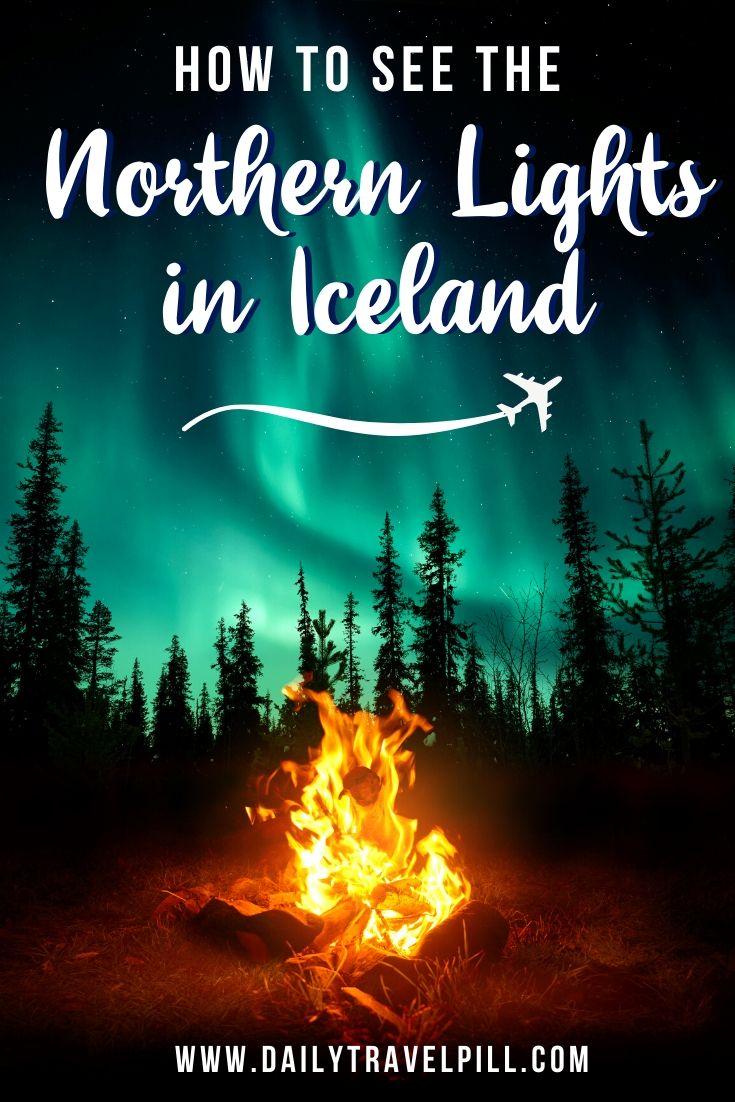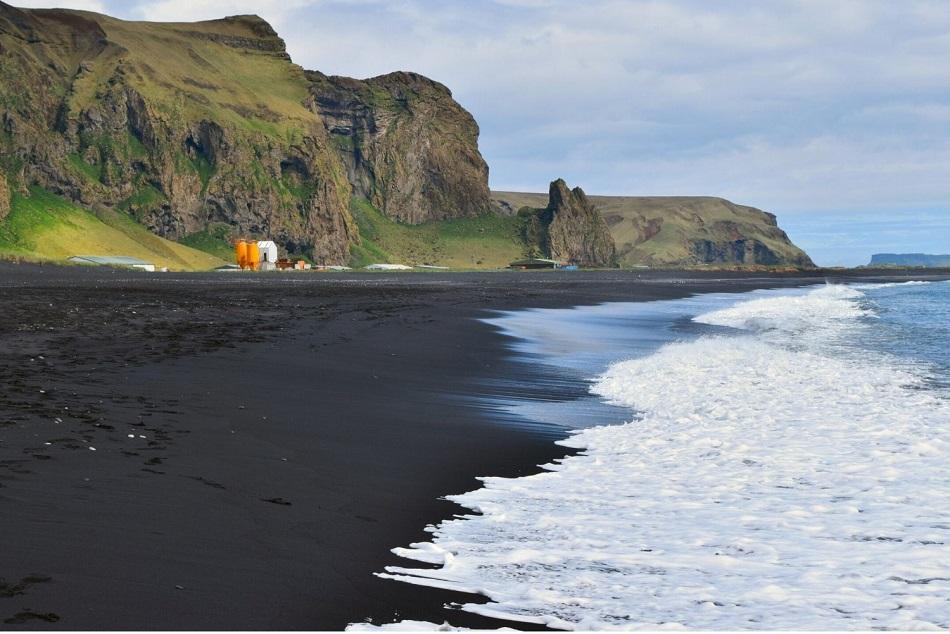Seeing the Aurora Borealis is one of the most popular bucket list activities for every traveler. There’s something magical about the Northern Lights that attracts tourists from all around the world to see them dancing. And what better place to enjoy the Northern Lights than Iceland?
Apart from its white glaciers and black sand beaches, Iceland is also known for its green and purple skies. However, many things have to synchronize in order the see the Northern Lights in Iceland.
In this article I am going to talk about the best time to see the Aurora Borealis in Iceland and the best places to see it.

The first and most important thing is to set your expectations. Please, don’t make from seeing the Aurora Borealis a goal for your trip to Iceland.
You have to take into consideration that there’s a chance you won’t see it. Accepting this will eliminate the risk of leaving Iceland disappointed and frustrated. Instead, think of all the majestic mountains and breathtaking glaciers that you are about to see. Make them a priority and think about the Northern Lights as a bonus.
-> Read my 20 Iceland tips & tricks for a perfect holiday – click here.
The best time to see the Aurora Borealis in Iceland

The best time of the year to see the Aurora Borealis in Iceland is starting with late August and ending with early April. For the dancing lights to appear on the sky you need total darkness.
This is why during the months with plenty of light it is not possible to see them. However, visiting Iceland during these ‘dark’ months does not guarantee that the Northern Lights will dance for you. There are many other unpredictable factors that influence whether or not the Aurora Borealis will appear on the sky.
No time to read now? Pin it for later!



Solar activity
The Aurora Borealis takes place when charged particles emitted by the sun enter the earth’s magnetic shield and collide with atoms and molecules from our atmosphere. These collisions take form as photons, which are little flares of light. This is what we basically see as the green light of Northern Lights.
The chance of the Aurora Borealis appearing can be accurately predicted only about two hours before it happens. An awesome tool to check the Iceland Aurora Borealis forecast is this website – click here. An intensity over the value of 2 means that there is a pretty good chance to see it.
Weather
You know the saying ‘unpredictable like the weather’. Well, the weather is one of the key factors that influence whether or not you are going to see the Aurora Borealis. You will need clear skies to see it.
The only thing you can do is check the Aurora forecast and see if there are are any white spots on the map. The white areas represent the places where you will have a better chance to see the Northern Lights.
To sum it up, there are 3 crucial things that need to happen at the same time in order for the Aurora Borealis to appear: darkness, solar activity, and clear skies. I wasn’t joking when I said that chances are you won’t see the Northern Lights during your trip but there is no reason to panic. With or without the green lights dancing on the sky, Iceland is still fabulous.
The best places in Iceland to see the Aurora Borealis
I would strongly recommend renting a car to chase the lights (check out these tips & tricks about driving in Iceland). This will give you the flexibility to drive to see the Aurora Borealis following the Aurora forecast.
Therefore, if you see an area with clear skies and good Aurora intensity, you can easily drive there and increase your chances of seeing it. However, if you don’t like spontaneity and would like to drive to one place and wait for the magical green lights to appear, below are some suggestions of amazing places.
Jokulsarlon Glacier Lagoon

This place is breathtaking just by itself. The seals swimming between the floating chunks of ice create an unforgettable scenery. Add some green lights on the sky and you will be mesmerized.
Kirkjufell

Maybe one of the most iconic places in Iceland, Kirkjufell Mountain is a great place for watching the Northern Lights. Read this post and find out which are the top 5 must-see places in Iceland.
Vik Beach

Known for its black sand and basalt rock formations, Vik Beach is a great place to watch the sky come to life. Watching the Aurora Borealis reflecting into the water while listening to the sound of waves is a once in a lifetime experience.
Eldhraun
Far away from the city lights, Eldhraun is great for watching the Northern Lights. The green moss with the green sky will create stunning pictures.
-> Read more about Iceland hereThingvellir National Park

Just a short ride away from Reykjavik, Thingvellir National Park is a popular place among the Aurora Borealis hunters. Find a safe place to park your car and enjoy the show!
Of course, there are many other amazing places to see the Northern Lights. The one thing that you must keep in mind when deciding where to go is to find a spot away from the city lights.
If you keep in mind the best time to see the Aurora Borealis in Iceland and actively look for places with clear sky and solar activity on this website, you will increase your chances of seeing the Northern Lights.
There is one more thing to remember: in reality, the dancing lights are not as bright as they appear in most of the photos. Almost all the shots are taken with long exposure. This means that the camera gathers the light particles from a longer period of time in one shot. Don’t be disappointed if the Aurora Borealis won’t look as bright in reality as it does in the photographs.
I think that the most important thing when starting the hunt for the Northern Lights is to adjust your expectations. Iceland is such a beautiful country and it has a lot to offer in terms of culture and nature.
May the travel bug bite you!

I was just in Iceland, and it was definitely not the right time to see the Northern Lights! That Midnight sun is no joke! I’m hoping to go back in October some time to try and see those Northern Lights!
I can’t wait to see the Aurora Borealis!
I’m a Northern Lights chaser, and I spent 2 weeks in Iceland driving around, seeing the gorgeous landscapes and hoping to see the Northern Lights. Iceland tends to be quite cloudy, so your biggest issue is avoiding the clouds. The south/west parts of the island seem to be the cloudiest… your best bet for clearer skies is actually in the north. I would imagine basing out of Akureyri and being willing to drive a few hours to clear skies is a better bet. There’s FAR fewer tourists up north too, and less of the iconic Icelandic sights. (Krafla volcano and Myvatn thermal baths are the big things… the hot spring caves from Game of Thrones are up there too! One of my favorite spots.)
If you are purely hunting auroras, go to Abisko or Tromso for a week… pretty much guaranteed to see them at least once. In 2 weeks in Iceland, I saw strong lights once moderate northern lights 2 times, and weak ones a bit more. If you can see the sky there, it will almost always have a greenish tinge towards the north on a long exposure. Of all the people I met in those 2 weeks, I saw them way more than anyone else because I was DETERMINED to see them. I was persistent. I went outside every hour for most evenings when there was clear sky and a good Kp value. If I saw a break in the clouds on the map, I drove there (and was handsomely rewarded!)
Thanks so much for sharing all this information!
I went to Iceland 2 years ago to see the northern lights and had zero luck. I’ll just have to go back ?
You should definitely go back!
I’ve always wanted to learn more about the Northern Lights, and now I do! Thank you.